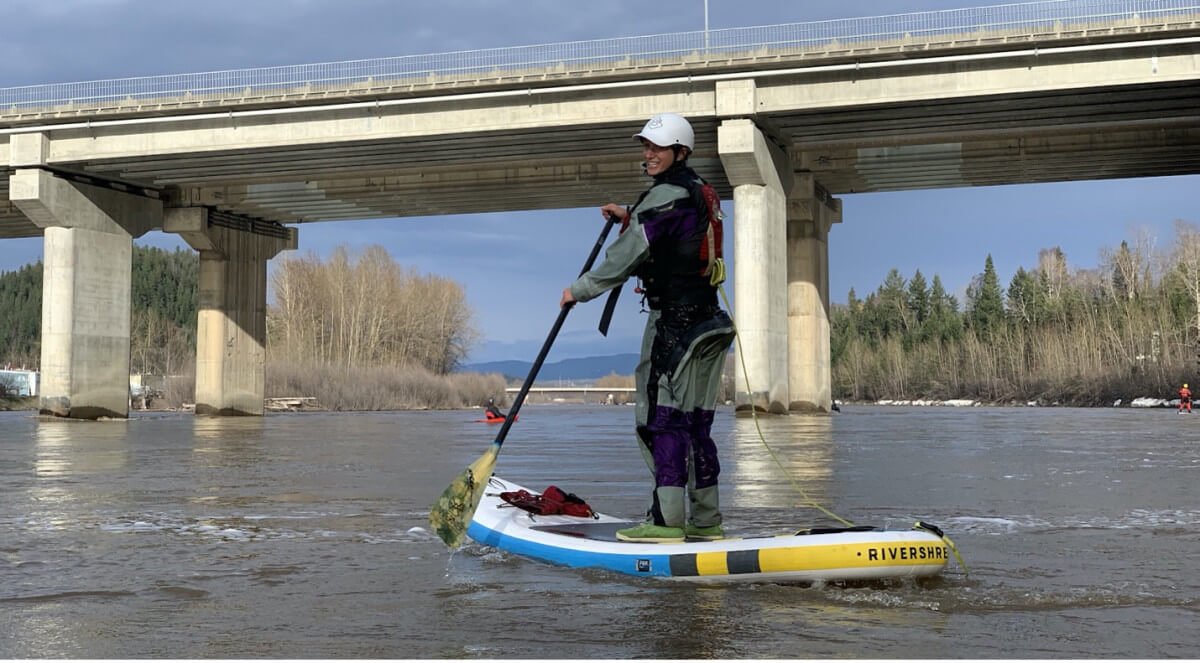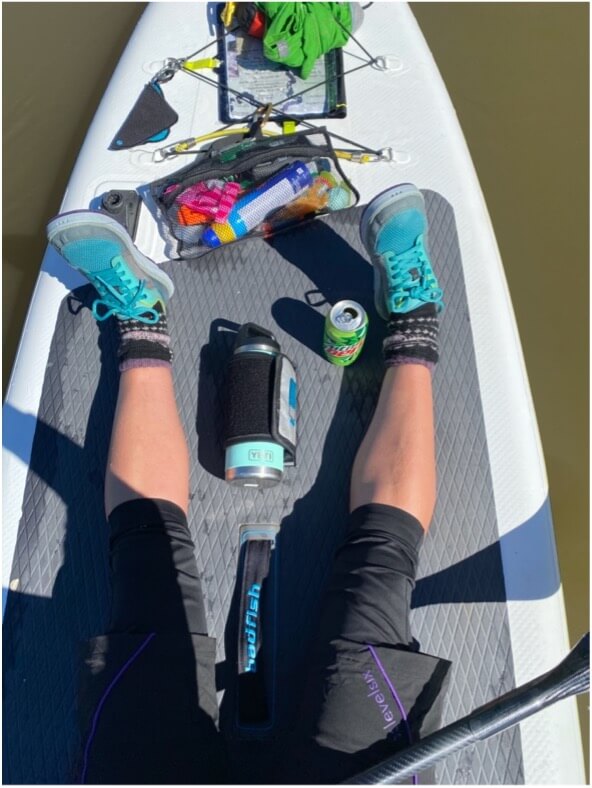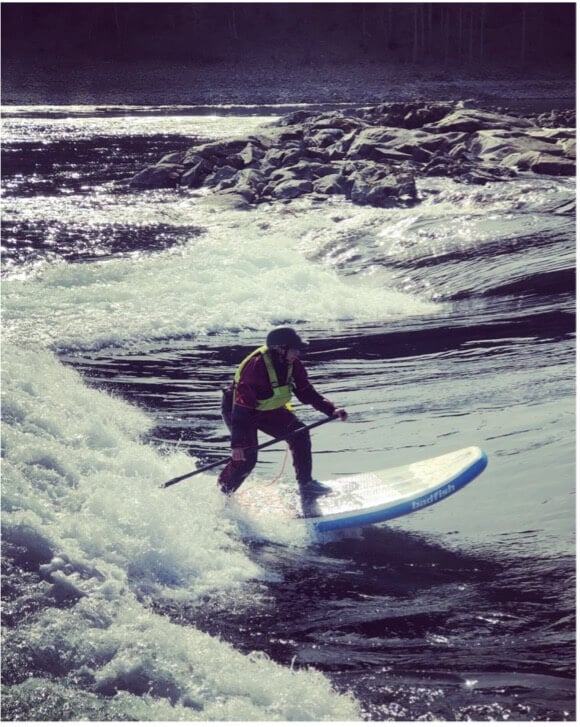Over the past five years I’ve begun to explore more places on my paddle board and incorporate longer multi-day expeditions as I’ve realized the potential that my SUP has for camping.
My longest trip so far has been four days, three nights with time constraints of family, work and life. This amount of gear easily fits on my board. In the future, however, I would like to do a solo SUP trip.
SUP Camping: Sleeping on Your Paddle Board
This past summer I was able to get out numerous times on the water with friends for a few multi-day trips. I purchased The Outdoor Research Helium Bivy to cut weight and space in my dry bags.
Pictured here is my sleeping bag, sleeping pad, pillow and bivy all ready to go.
Total weight: 6.68 lbs. If I took my lighter sleeping bag it would be: 4.1 lbs.
DELUXE GEAR HAULER
Currently I’m paddling The Badfisher by Badfish SUP; 11’ 6” L and 36” W. It provides a wide berth for my bivy. The fins are not removable but if you’re on soft ground they don’t get damaged. You can lay a log/rock under the board tail end to distribute the weight should you be on really hard ground.
Although the Badfisher is marketed as an angling board for fishing, it is so much more. You can fit so much gear on here and still feel stable.
The advantage of the stand-up paddle board is you have a giant inflatable sleeping pad to use as your base. It’s easy to maneuver into an area for safe sleeping depending on water levels and weather.
The SUP can be set down on rocky, unlevel surfaces to create a flat surface to sleep on.
SLEEPING ON YOUR SUP

Set up along the Athabasca River, AB September 2020
My paddle served as a pole for the tarp set up over my board to avoid the bivy getting wet. By itself, the bivy is waterproof and would suffice to sleep in just as it is without added protection. I preferred to have some shelter from wind and rain while getting in and out.
You’ll notice how tight to the ground my tarp is over my board. If you’ve even been in a big storm it always has big wind with it. This configuration would ride out a strong wind should you need to.
First night lesson; don’t have too much of an angle to your paddle board or you end up at the bottom of your sleeping bag/bivy/board.
Part way through the night I put my clothing bag at the foot of my bivy to bolster me up higher.
VASOTHERMAL MISREGULATION
Did you know that the above term is the clinical description of hot flashes caused by menopause? Fun fact!
I digress; however, I’m generally always cold 24/7 even when I think I’m warm my extremities are not. Thank you, Raynaud’s Syndrome. My regulation of heat is not good, except if I have a warm moment which is becoming more prevalent with age (refer to above description).
I’ve rode out many a big storm in my hammock and tent, however I’ve yet to get close up with one in my Bivy. It will happen this year, I have no doubt.
The low overnight temperature was 10C on this trip. Using my Bivy, I went to bed with polar fleece pants on and my down jacket/sweater layered on top along with a toque and wool socks. I could sleep with my arms out of the bag, my upper body was perfect however my legs overheated.
Unusual for me since I’m always cold, but too hot isn’t enjoyable either. One consideration of the Bivy is it takes very little time to warm up, the air space is so small. Lesson learned, the next night was cooler temperatures around 7C and I slept with just leggings. I was much more comfortable.
DO YOU LIKE TIGHT SPACES?
Personally, I’m not claustrophobic but I’m also not a fan of tight spaces. I endured the Bivy but with practice you would become accustomed to it.
There is a small hoop frame that keeps the netting off your face. If you’re claustrophobic it will be an uncomfortable sleep. It is tight. I’m 5’ 5” 135 lbs with lots of room to turn adjust accordingly for your comfort level.
Since I chose to put my NeoAir Thermarest in my bivy for extra support and as an adjustable sleeping pad it does make it tighter in there. You don’t need it, but I have back pain: the ability to adjust the Thermarest offers me reprieve.
I couldn’t zip it up completely the first night -- it felt too close. The next night I was far less worried and had a lot better sleep with it zipped closed and I was exhausted. Which is Murphy’s Law of any outdoor trip: night one is an awful sleep, night two you’re too tired to care and pass out.
THOUGHTS: PROS/CONS
Pros:
- Ultralight weight
- Compact
- Fast, easy set up without the tarp, simply climb in on or off your SUP
- Great for solo expeditions or if you don’t like to share tents
- Dries quickly
- Screen is nice to have airflow
- Warms your body up quickly (ideal for survival situations)
Cons:
- Tight space
- Screen isn’t stiff enough to stay completely off your face
- Getting dressed is interesting if you’re with a group you don’t want to strip in front of…but are they really your paddling partners then??
An alternative to the Bivy is finding a solo tent that fits onto your board space. Many people are SUP camping with these set ups as well. Anything we do in life is about finding what works for YOU best! So, remember you’re never tied to one system; borrow gear and explore your options.
DREAM BIG! PADDLE GOALS AHEAD
With the big paddle goal of paddle boarding from Jasper to Athabasca 650 km in 2021, I suspect this system will be an imperative part of it. I have a feeling I will be tired enough that I won’t care where I sleep and the amount of energy I have for setting up and tearing down camp will match just climbing into a Bivy.
I’d love to see some of your SUP sleeping arrangements! Feel free to tag me in your stories to see what awesome SUP camping you’re doing.
Happy paddling!
Lisa Stocking
AQ Ambassador
Advanced Flatwater SUP Instructor
@love_nsup
AQ Outdoors Contact
Edmonton: (p) 780 463-4892 (e) info@aquabaticsedmonton.com
Calgary: (p) 403 288-9283 (e) info@aqoutdoors.com


























































